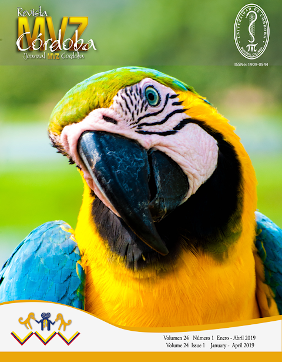Spirocerca lupi in dogs of Yucatan, Mexico: Case report and retrospective study
Spirocerca lupi en perros de Yucatán, México: Reporte de caso y estudio retrospectivo
Show authors biography
Objective. To describe the case report of a parasitized dog with Spirocera lupi in Yucatan, Mexico, as well as report cases registered in two laboratories during 18 years of parasitological and necropsy studies (2000-2017). Materials and methods. A case study is reported, with necropsy, histological and parasitological findings. Likewise, a retrospective study of cases reported in two laboratories where necropsies and faecal Flotation techniques (centrifugal and McMaster) were performed. Results. At the necropsy of the dog, three esophageal nodules were observed, which showed nematodes of S. lupi during the incision of the mass. The histological study showed an eosinophilic granuloma that contained the nematodes at its center, surrounded by a moderate inflammatory infiltrate formed by neutrophils, eosinophils, lymphocytes, plasma cells and macrophages, delimited by a capsule of fibrous connective tissue. In the retrospective study, prevalence of 0.18 and 0.48% were found by coprological tests and necropsy study, respectively. Conclusions. Spirocerca lupi is present in dogs from Yucatan, Mexico with low prevalence, producing in the esophagus of dogs lesions characterized by eosinophilic granulomas. The need to include this pathology in the differential diagnosis of esophageal and respiratory problems in dogs is disclosed.
Article visits 2309 | PDF visits
Downloads
Psáder R, Balogh M, Pápa K, Sterczer A, Lukács Z, Harnos A. Occurrence of Spirocerca lupi infection in hungarian dogs referred for gastroscopy. Parasitol Res. 2017; 116:S99–S108. https://doi.org/10.1007/s00436-017-5496-9
Lobetti R. Spirocercosis. Canine and feline gastroenterology. Washabau RJ, Day MJ (ed). Elsevier Saunders; St. Luis: 2013.
Ranen E, Lavy E, Aizenberg I, Perl A., Harrus S. Spirocercosis - associated esophageal sarcomas in dogs. A retrospective study of 17 cases (1997-2003). Vet Parasitol. 2004; 119(2-3):209-221. https://doi.org/10.1016/j.vetpar.2003.10.023
Christie J, Schwan EV, Bodenstein LL, Sommerville JE, Van der Merwe LL. The sensitivity of direct faecal examination, direct faecal flotation, modified centrifugal faecal flotation and centrifugal sedimentation/flotation in the diagnosis of canine spirocercosis. J S Afr Vet Assoc. 2011; 82:71-75.
Wright I. Spirocerca lupi - a potential future problem for pets travelling to Europe. Companion Anim. 2015; 20(3):156-160. https://doi.org/10.12968/coan.2015.20.3.156
van der Merwe LL, Kirbergera RM, Clift S, Williams M, Keller N, Naidoo V. Spirocerca lupi infection in the dog: A review. Vet J. 2008; 176:294-309. https://doi.org/10.1016/j.tvjl.2007.02.032
Giannelli L, Baldassarre V, Ramos RAN, Lia RP, Furlanello T, Trotta M et al. Spirocerca lupi infection in a dog from southern Italy: an old fashioned disease? Parasitol Res. 2014; 113:2391. https://doi.org/10.1007/s00436-014-3912-y
Elias F, Barros RM, Santos-Junior HL, Eloi RSA, Silva V, Freitas F, Fonseca-Alves CE. Pathological alterations in dogs resulting from parasitism by Spirocerca lupi. Acta Sci Vet. 2016; 44(Suppl 1):145. http://revistas.bvs-vet.org.br/actascivet/article/view/31571/34927
Cantó GJ, García MP, García A, Guerrero MJ, Mosqueda J. The prevalence and abundance of helminth parasites in stray dogs from the city of Queretaro in central Mexico. J Helminthol. 2011; 85:263-269. https://doi.org/10.1017/S0022149X10000544
Quiñones-Avila F, Espaine AL, Rodríguez-Vivas RI, Domínguez-Alpizar J. Contribución al estudio de los helmintos del tracto digestivo en perros de la ciudad de Mérida, Yucatán, México. Rev AMMVEPE 1998; 9(6):191-193.
INEGI (Instituto Nacional de Estadística, Geografía e Información) [Base de datos de internet]. Anuario estadístico y geográfico de Yucatán México. 2017 [actualizado el 28 de abril de 2018]. URL Disponible en: http://www.datatur.sectur.gob.mx/ITxEF_Docs/YUC_ANUARIO_PDF.pdf
Rodríguez-Vivas RI editor. Técnicas para el diagnóstico de parásitos con importancia en salud pública y veterinaria. AMPAVE-CONASA; México DF: 2015.
Bowman DD, Lynn RC, Eberhard ML. Georgi’s parasitology for veterinarians. 8th edn. St. Louis, Missouri; Saunders: 2003.
Mescher AL. Junqueira’s Basic Histology: Text and Atlas. 14th Edition. Ed. McGraw-Hill Education; New York, USA: 2016.
Schueneman de AA, Constantino CF. Técnicas de necropsia en animales domésticos. 2a edición. Manual Moderno; México, D.F: 2002.
Minnaar WN, Krecek RC. Helminths in dogs belonging to people in a resource-limited urban community in Gauteng, South Africa. J Vet Res. 2001; 68:111–117. PMID: 11585088
Dantas-Torres F, Otranto D. Dogs, cats, parasites, and humans in Brazil: opening the black box. Parasit Vectors. 2014; 7:22. https://doi.org/10.1186/1756-3305-7-22
Lobetti R. Follow-up survey of the prevalence, diagnosis, clinical manifestations and treatment of Spirocerca lupi in South Africa. J S Afr Vet Assoc. 2014; 85(1):7. https://doi.org/10.4102/jsava.v85i1.1169
Shubhagata D, Abdul A, Mohammad MH, Suchandan S, Muraduzzaman M. Spirocercosis in stray dogs of Chittagong Metropolitan area of Bangladesh: an epidemiological and pathological investigation. Vet World. 2011; 4:485-491. https://doi.org/10.5455/vetworld.2011.485-491
Chikweto A, Bhaiyat MI, Tiwari KP, de Allie C, Sharma RN. Spirocercosis in owned and stray dogs in Grenada. Vet Parasitol. 190; 2012:613-616. https://doi.org/10.1016/j.vetpar.2012.07.006
Rodriguez-Vivas RI, Ojeda-Chi MM, Trinidad-Martinez I, Pérez de León AA. First documentation of ivermectin resistance in Rhipicephalus sanguineus sensu lato (Acari: Ixodidae). Vet Parasitol. 2017; 233:9-13. https://doi.org/10.1016/j.vetpar.2016.11.015
Austin CM, Kok DJ, Crafford D, Schaper R. The efficacy of a topically applied imidacloprid 10 %/moxidectin 2.5 % formulation (Advocate®, Advantage® Multi, Bayer) against immature and adult Spirocerca lupi worms in experimentally infected dogs. Parasitol Res. 2013; 112:91–108. https://doi.org/10.1007/s00436-013-3284-8
Mylonakis ME, Koutinas AF, Liapi MV, Saridomichelakis MN, Rallis TS. A comparison of the prevalence of Spirocerca lupi in three groups of dogs with different life and hunting styles. J Helminthol. 2001; 75:359-361. PMID: 11818054
Rodríguez-Vivas RI, Basto-Estrella G, Reyes-Novelo E, Delfín-González H, Pérez-Cogollo LC, Ojeda-Chi M et al. Escarabajos estercoleros en Yucatán, México: Especies, distribución estacional e incorporación de excretas al suelo. Rev Nuestro Agro. 2014; 1:18-24.
Diakou A, Karamanavi E, Eberhard M, Kaldrimidou E. First report of Spirocerca lupi infection in red fox Vulpes vulpes in Greece. Wildl Biol. 2012; 18(3):333-336. https://doi.org/10.2981/11-094
Mukorera V, van der Merwe LL, Lavy E, Aroch I, Dvir E. Serum alkaline phosphatase activity is not a marker for neoplastic transformation of esophageal nodules in canine spirocercosis. Vet Clin Pathol. 2011; 40(3):389-392. https://doi.org/10.1111/j.1939-165X.2011.00331.x
Klainbart S, Mazaki-Tovi M, Auerbach N, Aizenberg I, Bruchim Y, Dank G. Spirocercosis - associated pyothorax in dogs. Vet J. 2007; 173(1):209-214. https://doi.org/10.1016/j.tvjl.2005.08.019
Santos ASO, Silveira LS, Lemos LS, Moreira L, Silva AC, Carvalho ECQ. Aneurismas aórticos pela espirocercose canina em Brasília (Relato de caso). Rev Bras Saúde Prod Anim. 2004; 5(1):25-30. http://revistas.ufba.br/index.php/rbspa/article/view/628/385
























